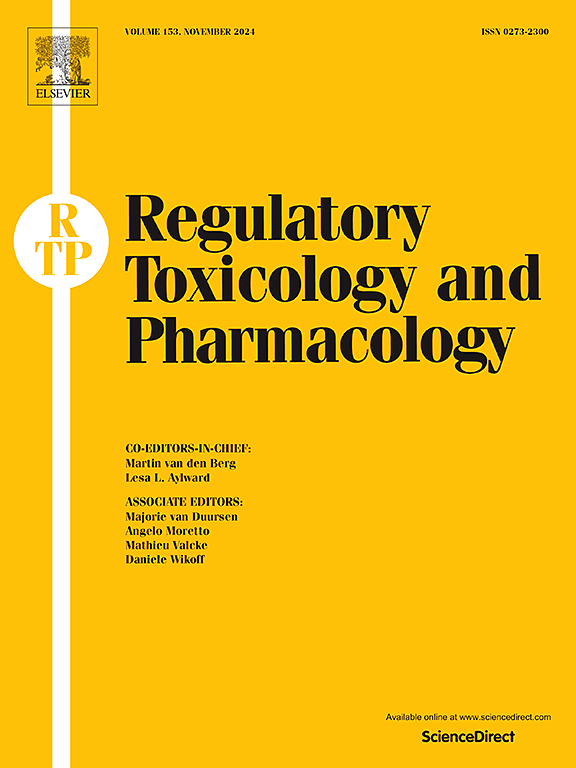Assessment of endocrine disruptors in the European Union: Current regulatory framework, use of new approach methodologies (NAMs) and recommendations for improvements
IF 3.5
4区 医学
Q1 MEDICINE, LEGAL
引用次数: 0
Abstract
Exposure to endocrine disruptors (EDs) are associated with significant risks to human health and the environment. The European Union (EU) thus prioritizes their identification and regulation and is developing a roadmap to phase out animal testing in chemical safety assessments while advancing New Approach Methodologies (NAMs). This review outlines EU's practices for ED identification, focusing on the use of NAMs, as well as Defined Approaches and read-across. We assessed the current EU framework under the Classification, Labelling and Packaging (CLP) Regulation, the Registration, Evaluation, Authorisation and Restriction of Chemicals (REACH), the Plant Protection Products Regulation (PPPR), and the Biocidal Products Regulation (BPR), evaluating current use of NAMs and reflection on potential future use. We find that EU legislation and guidance documents allow the use of NAMs in ED identification, including for assessment of endocrine activity and adversity. However, guidance on predicting adversity using NAMs remains limited, and ED identifications have largely depended on animal data to assess endocrine-mediated adversity. Continued in vivo testing until reliable methodologies are accepted as alternatives and routinely applied is required. The report concludes with short- and long-term recommendations for updates to the information requirements across regulations and further development of methods to predict endocrine-mediated adversity.

欧盟对内分泌干扰物的评估:现行监管框架,新方法方法(NAMs)的使用和改进建议。
接触内分泌干扰物会给人类健康和环境带来重大风险。因此,欧洲联盟(EU)优先考虑对其进行识别和监管,并正在制定路线图,逐步淘汰化学品安全评估中的动物试验,同时推进新方法方法(NAMs)。本综述概述了欧盟在ED识别方面的实践,重点是NAMs的使用,以及定义方法和解读。我们根据分类、标签和包装(CLP)法规、化学品的注册、评估、授权和限制(REACH)、植物保护产品法规(PPPR)和杀菌剂产品法规(BPR)评估了当前的欧盟框架,评估了NAMs的当前使用情况,并对潜在的未来使用进行了反思。我们发现欧盟立法和指导文件允许在ED鉴定中使用NAMs,包括评估内分泌活动和逆境。然而,使用NAMs预测逆境的指导仍然有限,ED的鉴定在很大程度上依赖于动物数据来评估内分泌介导的逆境。继续进行体内试验,直到可靠的方法被接受为替代方法并常规应用。该报告最后提出了短期和长期建议,以更新各法规的信息要求,并进一步发展预测内分泌介导的逆境的方法。
本文章由计算机程序翻译,如有差异,请以英文原文为准。
求助全文
约1分钟内获得全文
求助全文
来源期刊
CiteScore
6.70
自引率
8.80%
发文量
147
审稿时长
58 days
期刊介绍:
Regulatory Toxicology and Pharmacology publishes peer reviewed articles that involve the generation, evaluation, and interpretation of experimental animal and human data that are of direct importance and relevance for regulatory authorities with respect to toxicological and pharmacological regulations in society. All peer-reviewed articles that are published should be devoted to improve the protection of human health and environment. Reviews and discussions are welcomed that address legal and/or regulatory decisions with respect to risk assessment and management of toxicological and pharmacological compounds on a scientific basis. It addresses an international readership of scientists, risk assessors and managers, and other professionals active in the field of human and environmental health.
Types of peer-reviewed articles published:
-Original research articles of relevance for regulatory aspects covering aspects including, but not limited to:
1.Factors influencing human sensitivity
2.Exposure science related to risk assessment
3.Alternative toxicological test methods
4.Frameworks for evaluation and integration of data in regulatory evaluations
5.Harmonization across regulatory agencies
6.Read-across methods and evaluations
-Contemporary Reviews on policy related Research issues
-Letters to the Editor
-Guest Editorials (by Invitation)

 求助内容:
求助内容: 应助结果提醒方式:
应助结果提醒方式:


